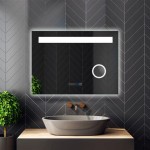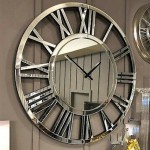Frame My Bathroom Mirror
Framing a bathroom mirror elevates the room's aesthetic, adding a touch of sophistication and personality. Whether aiming for a modern, rustic, or traditional look, a well-chosen frame can transform a simple mirror into a focal point. This process, while achievable for DIY enthusiasts, requires careful planning and execution for optimal results.
Key Considerations Before Starting
Several factors influence the frame selection and installation process. Considering these points beforehand will contribute to a successful outcome.
- Mirror Size and Shape: Accurate measurements are crucial for selecting the appropriate frame size. The frame should complement, not overwhelm, the mirror's dimensions and shape.
- Bathroom Style: The frame should harmonize with the overall bathroom design. A sleek metal frame complements a modern bathroom, while a wooden frame suits a more traditional setting.
- Material Selection: Bathroom environments are exposed to humidity. Opt for moisture-resistant materials like treated wood, metal, or synthetic materials designed for bathrooms.
- Budget: Frame options range from budget-friendly to high-end. Setting a budget beforehand helps narrow down the choices and prevents overspending.
Choosing the Right Frame Material
The frame material significantly impacts the final look and durability. Each material offers distinct advantages and disadvantages.
- Wood: Provides a classic, warm aesthetic. Choose treated wood specifically designed for humid environments to prevent warping or damage. Regular sealing is necessary to maintain its integrity.
- Metal: Offers a sleek, modern look. Aluminum or stainless steel are ideal choices due to their resistance to rust and corrosion. Metal frames require minimal maintenance.
- Plastic or PVC: A cost-effective and moisture-resistant option. These materials are available in various finishes, mimicking the appearance of wood or metal. They are lightweight and easy to install.
- Mosaic or Tile: Creates a unique, decorative frame. Choose water-resistant tiles and adhesives suitable for bathroom applications. This option can be more time-consuming to install.
Measuring and Preparing for Installation
Accurate measurements are essential for a proper fit. Careful preparation ensures a smooth installation process.
- Precise Measurements: Measure the mirror's length and width accurately. Double-check measurements to avoid errors.
- Surface Preparation: Clean the mirror surface and surrounding wall area thoroughly. Remove any dust or debris that could interfere with adhesion.
- Gather Necessary Tools: Assemble all required tools, including a measuring tape, level, adhesive, safety glasses, and any necessary cutting tools for the frame material.
Installation Methods
Different frame materials require specific installation techniques. Understanding these methods ensures a secure and aesthetically pleasing result.
- Adhesive Application: Construction adhesive is commonly used for attaching frames to mirrors. Apply adhesive evenly to the back of the frame or directly to the mirror, following the manufacturer's instructions.
- Clips and Brackets: Some frames are designed with clips or brackets that secure the frame to the mirror. This method is often used for heavier frames or situations where adhesive alone is insufficient.
- Liquid Nails: Liquid nails provide a strong bond for various materials. Ensure proper ventilation during application and allow adequate drying time.
- Mirror Mounting Clips (for heavier frames): For substantial frames, consider using mirror mounting clips alongside adhesive for added support and stability.
Finishing Touches and Maintenance
The final steps and ongoing maintenance contribute to the longevity and appearance of the framed mirror.
- Caulk and Sealant: Apply caulk or sealant around the perimeter of the frame to create a watertight seal and prevent moisture from seeping behind the frame. This step is crucial for preventing mold and mildew growth.
- Cleaning and Care: Regularly clean the frame with a damp cloth and mild detergent. Avoid abrasive cleaners that could damage the frame's finish. For wooden frames, reapply sealant periodically to maintain moisture resistance.
- Inspect for Damage: Periodically inspect the frame for any signs of damage, such as cracks, warping, or loose joints. Address any issues promptly to prevent further deterioration.
Choosing a Frame Style
The frame style significantly impacts the overall bathroom aesthetic. Careful selection complements existing décor and personal preferences.
- Modern Frames: Characterized by clean lines and simple designs. Materials such as metal, sleek wood, or even minimalist plastic frames contribute to this contemporary look.
- Traditional Frames: Often feature ornate details, carvings, and richer wood finishes. These frames create a classic and elegant atmosphere.
- Rustic Frames: Emphasize natural materials and textures. Reclaimed wood, textured metal, or even stone can contribute to a rustic charm.
- Transitional Frames: Blend elements of both modern and traditional styles. These frames offer a balance between clean lines and subtle detailing.
Working with Unique Mirror Shapes
Framing uniquely shaped mirrors requires careful planning and sometimes custom solutions. Consider these aspects when dealing with non-rectangular mirrors.
- Custom Framing: For complex shapes, custom framing may be the best option. Professional framers can create frames that perfectly fit the mirror's contours.
- Flexible Molding: Flexible molding can be used to create curved or irregular shapes. This material can be bent and shaped to conform to the mirror's outline.
- Tile or Mosaic: Tile or mosaic offers versatility for unique shapes. Individual tiles can be arranged to follow the mirror's edges, creating a custom frame.
DIY vs. Professional Framing
Choosing between a DIY project and hiring a professional depends on individual skills and the complexity of the project.
- DIY Framing: Suitable for simple, rectangular mirrors and standard frame materials. This option offers cost savings and a sense of accomplishment.
- Professional Framing: Recommended for complex mirror shapes, intricate frame designs, or when specialized tools and expertise are required. Professional framers ensure a precise and high-quality finish.

How To Frame A Mirror

How To Install A Mirrorchic Bathroom Mirror Frame Momhomeguide Com

How To Frame Out That Builder Basic Bathroom Mirror For 20 Or Less

Easy Diy Tutorial Adding Trim Around A Giant Mirror For Ers

Diy Stick On Mirror Frame Sawdust Sisters

Mirror Frame Diy How To Update A Basic Bathroom Our Faux Farmhouse

Diy Bathroom Mirror Frame With Molding The Happier Homemaker

Diy Framed Bathroom Mirrors Living With Lady

Mirror Frame Diy How To Update A Basic Bathroom Our Faux Farmhouse

Diy Bathroom Mirror Frame Without Removing Clips Her Happy Home








